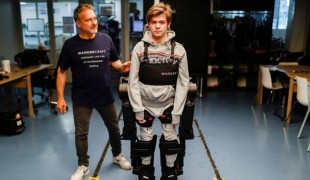- 5495
- 378
- 9
- 6
- 0
- Help Ukraine
About the solution
Due to his condition, Jack lives with self-injurious behaviours, which makes difficult for his mother to leave him alone. So she wanted him to wear a garment that would leave him safe.
The boy, who is non-verbal, loves to walk without assistance but he can’t find good balance because of his body movements. He also likes to crawl to windows, walls or furniture and bang his head as hard as he can. So a solution was needed, to prevent him to hurt himself.
“He does, however, have motor abilities. We love that he can walk when we hold his hand and want to maximize this one ability that God graced him with. If he could walk more stable, and if we could not have to get up every five seconds to move him from hurting himself, all of our lives would be affected positively, more than words can say”, his mother explained.
So Janet and Chris, volunteers from May We Help (an organisation that develops gadgets to increase the autonomy level of disabled people), built him a garment, which consists of an impact reduction wearable system. They used the following materials: a life vest, an airplane pillow and a fabric sleeve.
Jack got the device in 2015.
His mother was very happy with the outcome. “I am able to actually leave him alone to use the restroom, take a quick shower or grab the mail. Something I couldn't do before we had the system. It is too funny, Jack begins banging on the walls or doors, but then realises nothing is coming out of it. He usually just gives up and lays down. Janet changed the lives of our son, myself and my husband. Even my two girls, who don't have to watch him continue to hurt himself as he had been. My husband and I are just so grateful. It may seem like a small project, but the independence we the caretakers have gained, and the protection our son has gained, is absolutely priceless”, she said.
Adapted from: https://bit.ly/2F6BxEz
https://www.youtube.com/watch?v=Dfj1KaVsQc8
This solution shall not include mention to the use of drugs, chemicals or biologicals (including food); invasive devices; offensive, commercial or inherently dangerous content. This solution was not medically validated. Proceed with caution! If you have any doubts, please consult with a health professional.
DISCLAIMER: This story was written by someone who is not the author of the solution, therefore please be advised that, although it was written with the utmost respect for the innovation and the innovator, there can be some incorrect statements. If you find any errors please contact the patient Innovation team via info@patient-innovation.com
-
-
119
-
0
-
1292

Collaborator James Leckey makes equipment to improve the quality of life and social inclusion of children with special needs
MOVING IN A WHEELCHAIR: Moving using a wheelchair.
BODY BALANCE: Maintaining body balance
STANDING UP: Standing up from a seated position
Playing
Neuromuscular Disorders
Assistive Daily Life Device (to help ADL)
Walking Aid (wheelchair/walker/crutches)
Assistive Technology access
5 Senses support devices: (glasses, hearing aids, headphones...)
Restoring mobility
Promoting self-management
Managing Neurological Disorders
Promoting inclusivity and social integration
Maintaining Balance and Mobility
Raise awareness
General and Family Medicine
Neurology
Orthopedics
Pediatrics
Physical Medicine and Rehabilitation
United States
-
-
-
490
-
0
-
8129

Father creates special crutches to help his daughter
WALKING WITH A WALKING AID: Walking with a walking aid
STANDING UP: Standing up from a seated position
BODY BALANCE: Maintaining body balance
Walking Aid (wheelchair/walker/crutches)
Restoring mobility
Promoting self-management
Managing Neurological Disorders
Promoting inclusivity and social integration
Recovering from Traumatic Injuries
Maintaining Balance and Mobility
To improve Treatment/Therapy
Preventing (Vaccination, Protection, Falls, Research/Mapping)
Orthopedics
Pediatrics
Physical Medicine and Rehabilitation
Mobility issues
Pediatric Innovations
Solutions for Disabled people
United States
-
-
-
264
-
0
-
3979

Father creates exoskeleton to help son with genetic neurological condition walk
BODY BALANCE: Maintaining body balance
STANDING UP: Standing up from a seated position
WALKING WITH A WALKING AID: Walking with a walking aid
CAREGIVING
Cervical spinal cord injury/Tetraplegia
Assistive Technology access
Walking Aid (wheelchair/walker/crutches)
Restoring mobility
Managing pain
Promoting self-management
Preserving Organ Function
Managing Neurological Disorders
Recovering from Traumatic Injuries
Maintaining Balance and Mobility
Restoring Blood Circulation
To improve Treatment/Therapy
Preventing (Vaccination, Protection, Falls, Research/Mapping)
Raise awareness
Caregiving Support
General and Family Medicine
Intensive Care Medicine
Neurology
Physical Medicine and Rehabilitation
Sports Medicine
France
-
 en
en